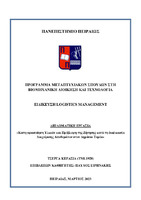Κατηγοριοποίηση υλικών και πρόβλεψη της ζήτησης κατά τη διαδικασία διαχείρισης αποθεμάτων στον δημόσιο τομέα
Material categorization and demand forecasting in the process of inventory management in the public sector

View/
Keywords
ABC ανάλυση ; Μέθοδοι πρόβλεψης ; Ζήτηση ; Μοντέλα ARIMA ; Διαχείριση αποθέματος ; Κατηγοριοποίηση αποθέματος ; Διαδικασία Box - Jenkins ; Χρονοσειρές ; Αυτοσυσχέτιση ; Πρόβλεψη ζήτησης ; Demand forecasting ; Κινούμενος μέσος ; Εκθετική εξομάλυνση ; Αυτοπαλινδρόμηση ; ACF ; PACF ; Inventory managementAbstract
Accurate demand forecasting of critical items is a vital step in business operational planning process. Any company that retains arbitrary, unrelated to demand inventory, could be led to undesirable and irreversible outcomes. It is clear that time series analysts have crucial role because they are called to process data, classify inventory and apply demand forecasting techniques so as to provide reliable forecasts. The results of these procedures are used in the decision making process to reserve company’s sustainability and development in order that a competitive advantage can be achieved.
Based on the above mentioned aspects, the aim of this thesis is to determine demand forecast as a function of inventory management in public sector. Specifically, through this study it is highlighted how important and useful predictions are, in a way that can affect procurement, retaining, monitoring and controlling of inventory in military logistics.
In line with the aforementioned aim, the theoretical background of inventory management is initially presented and then specific principles are applied on time series data. In particular, using ABC analysis (based on the demand value), material classification is implemented in the items that are managed by a military organization and a set of 19 spare parts is selected. Afterwards, some widespread forecasting techniques (such as moving average and exponential smoothing) as well as the stochastic ARIMA (Box- Jenkins) method are chosen and are tested on the time series spare parts set, using data since 2012. Then, measurement of the forecasting error of each tested method is evaluated, depending on the comparison between forecast results and the real, recorded demand data. Beneficial conclusions are drawn, as it is noted that there is a wide gap between theoretical approach and implementation of forecasting methods and consequently, because of complexity, the analyst has difficulty in choosing one method that properly fits in time series data. Finally, present research and proposed future research subjects indicate that even if residuals and uncertainty arise, the adoption of a forecasting policy is the only way for the military organization to ensure supply chain agility and the ability to adapt to demand changes immediately, effectively and optimally, aligning with cost reduction and fulfillment of the unique, distinct military requirements.


